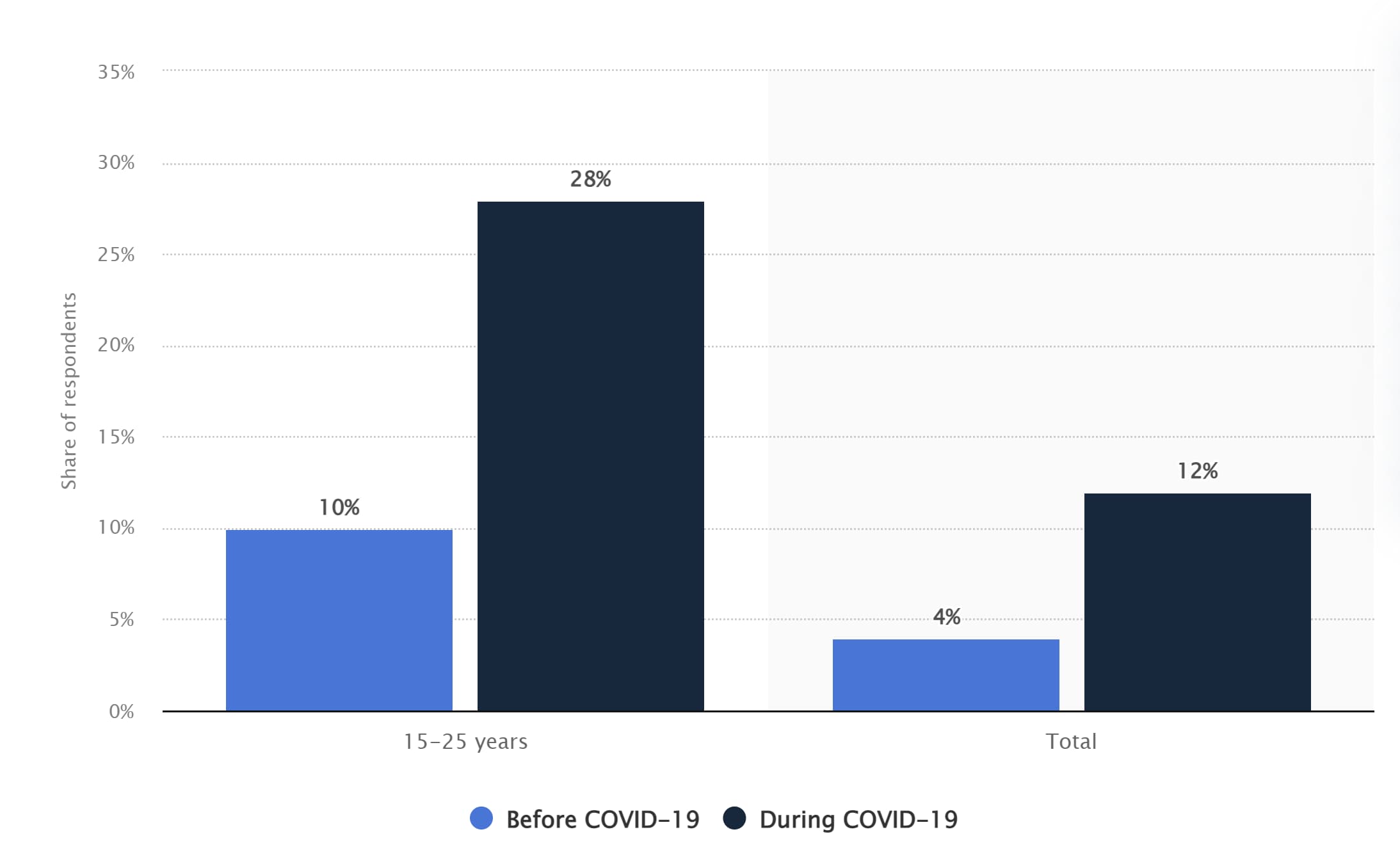Table of Contents
The media landscape has changed significantly over the years thanks to the rise of the internet and social media. With platforms like YouTube and TikTok, anyone can go online, create content, and find their niche audience. As a result, media has become more decentralized than ever, and millions of content creators have created a new space in the entertainment industry — the creator economy.
But what exactly is the creator economy, and why should marketers care? Here’s everything marketers need to know:
Social Media’s Role in the Creator Economy
Platforms with Content Creator Funds and Programs
How Brands Should Use the Creator Economy
What is the creator economy?
The creator economy is an online-facilitated economy comprised of millions of content creators, such as social media influencers, videographers, bloggers, and other digital creatives. The creator economy also includes software and tools designed to help these creators grow and profit from their content.
The creator economy is a relatively new addition to the media and entertainment industry, and it’s something that anyone from any generation can be a part of. Whether you’re a millennial with a true crime podcast or a Gen Z fashionista with a style blog — you can be a part of the creator economy in whatever niche you choose.
Think about it — if a TikTok account rating bathroom sinks around New York City can go viral, then there really is no limit to what’s possible in the content creation business.
Social Media’s Role in the Creator Economy
The rise of social media has fueled growth in the creator economy. According to Forbes, there are about 50 million content creators across multiple platforms, including YouTube, TikTok, Instagram, and Twitch. That’s about 50 million people participating in the creator economy.
The creator economy saw significant growth during the start of the COVID-19 pandemic. During this time, many people found themselves working from home or looking for new income streams due to budget cuts and layoffs. This resulted in more people having more time or incentives to create content on platforms like TikTok, Twitch, and YouTube.
In fact, TikTok saw a significant increase in users during the height of the pandemic, which directly contributed to a boom in the content creator economy. According to Statista, TikTok experienced a growth of 180% among users ages 15-25 after the pandemic broke out in the U.S. in 2020.
Aside from financial opportunities (and an escape from boredom), social media provides a digital space for almost anyone to post their content, promote their work, and build a loyal fanbase. In the creator economy, you can be a creator without investing in expensive equipment or getting the backing of major studios.
For example, Kyle Prue rose to fame on TikTok with videos showcasing his dry humor. All his videos are shot from his apartment using his iPhone and the mic on his Apple headphones. Despite his simple setup, Prue has over 1 million followers on TikTok and 32.5 million likes.
He also wrote and starred in his dark comedy-drama web series, “The Rabbit,” which he posted to YouTube for viewers to watch for free. Prue put the series together with his own money and without the help of any major studios or production companies. Each episode has between 20,000 to 71,000 views.
Platforms with Content Creator Funds and Programs
As I mentioned, many people turned to the creator economy to earn money — especially at the start of the pandemic when companies were experiencing hiring freezes and layoffs. Many digital platforms contribute to this economy via their creator funds and programs, including:
YouTube
For years, content creators on YouTube have made money via ad revenue from video advertisements. YouTube also has the YouTube Partner Programs, which gives creators access to exclusive features and various monetization opportunities. To compete with TikTok, YouTube also launched the YouTube Shorts Fund, dedicating a total of $100 million to creators from 2021 to 2022.
To keep up with the growing creator economy, Instagram has rolled out many new opportunities for creators to earn money off their posts to the app. One opportunity is the Instagram Live Badges, which allows users to send monetary tips to their favorite creators during live streams. Another opportunity is the Instagram Reels Play Bonus Program, where creators earn money based on the performance of their Reel.
Other monetary opportunities include:
- Branded content
- Shops for creators to sell directly to their followers
- In-stream video ads
- Affiliate programs
TikTok
TikTok’s Creator Next Program includes its $200 million creator fund, tipping and gifting opportunities, and a creator marketplace to connect creators with brands. The creator fund is accessible to many creators, including those with only 10,000 followers — so long as they have at least 100,000 video views within 30 days.
Twitch
Streaming platform Twitch has its Twitch Partner Program, where creators can earn income in multiple ways. One way is through channel subscriptions. With channel subscriptions, streamers earn revenue when their viewers subscribe via the following options: Tier 1, Tier 2, Tier 3, or Prime.
Bits is another feature of the program, allowing viewers to purchase virtual goods to “cheer” on streamers. Streamers get a percentage of the revenue Twitch receives from these purchases. And finally, Twitch streams can earn money via ad revenue from ads run during their streams.
Other Ways Content Creators Make Money
Though many social media platforms provide creators opportunities to make money through creator funds and programs, content creator earnings typically aren’t very high.
According to a survey by NeoReach and Influencer Marketing Hub, only 1.4% of the 2,000 content creators surveyed earn over $1.4 million annually. Only a little over 20% make a livable wage of $50K or more a year. To combat this issue, content creators will often supplement their income by other means, such as:
- Brand deals and partnerships
- Sponsored content
- Paid subscriptions
- VIP meet-ups
- Event hosting
- Merchandise
- Live and virtual events
Some content creators may also use their online presence as a stepping stone toward more lucrative ventures. For instance, Tabitha Brown is a social media personality and actress who became famous on TikTok for her calming videos of affirmations and recipes.
Her fame on social media led her to being cast in popular television shows like Showtime’s “The Chi.” Brown also has her own show, “All Love,” on Ellen DeGeneres’ digital platform EllenTube as well as a bestselling cookbook and an ongoing partnership with Target.
How Brands Should Use the Creator Economy
Viewers tend to care more about people and personalities than brands in the creator economy. As a result, many major brands have struggled to find their footing on platforms like TikTok or Twitch. However, there is still a way brands should tap into the creator economy to grow their audience and gain revenue — influencer marketing.
Brands should reach out to influencers with a loyal social media following to spread the word about their products or services. A great example of influencer marketing would be the work of TikTok personality Drew Afualo. Afualo is famous on TikTok for creating videos that poke fun at misogynists and uplift women.
Since gaining millions of followers on the app, Afualo has been tapped to promote films like “The Lost City,” starring Sandra Bullock and Channing Tatum.
Online fashion retailer Shein has also worked with Afualo to promote the company’s SheinX collection.
There are many ways to leverage Influencer marketing. Popular tactics include social media takeovers in which an influencer “takes over” a brand’s social media account for a day. Some brands like Genius will host live Q&As with influencers or celebrities on platforms like Instagram Live or Twitter Spaces. Additionally, paid partnerships, product placement, and sponsorships are considered tried and true methods.
Just remember — if you’re leveraging influencer marketing, you’ll need to ensure the influencer’s content and image align with that of your brand. After all, you should always practice discernment with who or what is associated with your brand or organization.
The creator economy is how influencers and creatives earn income by creating content that is unique to them and taps into their niche audience. However, it’s also an excellent avenue for brands to generate awareness and remain relevant in an ever-changing media landscape. Now that you know about this growing economy, you can find new and innovative ways to incorporate it into your marketing strategy.


![Download Now: 150+ Content Creation Templates [Free Kit]](https://no-cache.hubspot.com/cta/default/53/5478fa12-4cc3-4140-ba96-bc103eeb873e.png)






More Stories
Cloud Comfort: How Cloud Computing Simplifies Your Digital Life
How to Buy Your Next Pair of Glasses Online
Google Pixel Buds Vs Apple AirPods – The Battle of the Earbuds